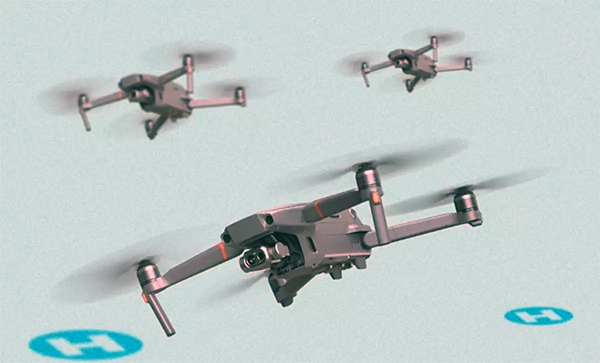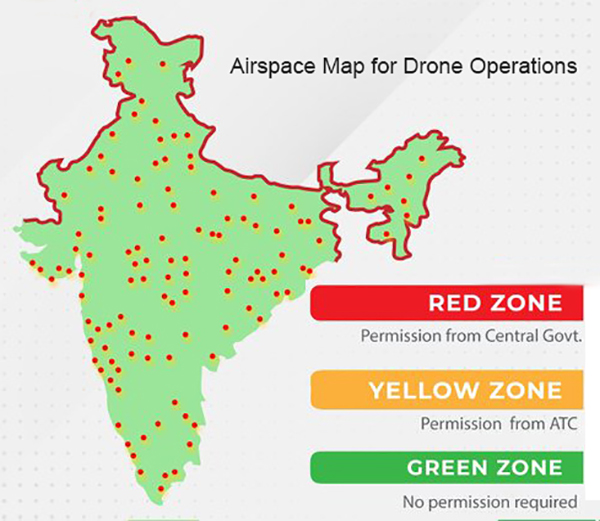Production Linked Incentive Scheme
The Central Government approved the Production-Linked Incentive (PLI) scheme for drones and drone components on 15 September 2021. The PLI scheme comes as a follow-through of the liberalised Drone Rules, 2021 released by the Central Government on 25 August 2021. The PLI scheme and new drone rules are intended to catalyse super-normal growth in the upcoming drone sector.
Thanks to the new rules and the incentive scheme, the drones and drone components manufacturing industry may see an investment of over Rs 5,000 crore over the next three years. The annual sales turnover of the drone manufacturing industry may grow from Rs 60 crore in 2020-21 fold to over Rs 900 crore in FY 2023-24. The drone manufacturing industry is expected to generate over 10,000 direct jobs over the next three years.
Under the PLI scheme, the incentive for a manufacturer of drones and drone components will be 20 per cent of the value addition made by the company during the next three years. The value addition should be calculated as the annual sales revenue from drones and drone components (net of GST) minus the purchase cost (net of GST) of drone and drone components, it stated.
Top 15 Features of the PLI Scheme
- The total amount allocated for the PLI scheme for drones and drone components is Rs 120 crore spread over three financial years. This amount is nearly double the combined turnover of all domestic drone manufacturers in FY 2020-21.
- The incentive for a manufacturer of drones and drone components shall be as high as 20% of the value addition made.
- The value addition shall be calculated as the annual sales revenue from drones and drone components (net of GST) minus the purchase cost (net of GST) of drone and drone components.
- The Government, has agreed to keep the PLI rate constant at 20% for all three years, an exceptional treatment given only to the drone industry. In PLI schemes for other sectors, the PLI rate reduces every year.
- The proposed tenure of the PLI scheme is three years starting in FY 2021-22. The PLI scheme will be extended or redrafted after studying its impact in consultation with the industry.
- The Government has agreed to fix the minimum value addition norm at 40% of net sales for drones and drone components instead of 50%, another exceptional treatment given to the drone industry. This will allow widening the number of beneficiaries.
- The PLI scheme covers a wide variety of drone components:
a. Airframe, propulsion systems(engine and electric), power systems, batteries and associated components, launch and recovery systems;
b. Inertial Measurement Unit, Inertial Navigation System, flight control module, ground control station and associated components;
c. Communications systems (radio frequency, transponders, satellite-based etc.)
d. Cameras, sensors, spraying systems and related payload etc.;
e. ‘Detect and Avoid’ system, emergency recovery system, trackers etc. and other components critical for safety and security. - The list of eligible components may be expanded by the Government from time to time, as the drone technology evolves.
- The Government has agreed to widen the coverage of the incentive scheme to include developers of drone-related IT products also.
- The Government has kept the eligibility norm for MSME and startups in terms of annual sales turnover at a nominal level – INR 2 cr (for drones) and INR 50 lakhs (for drone components). This will allow widening the number of beneficiaries.
- Eligibility norm for non-MSME companies in terms of annual sales turnover has been kept at INR 4 crore (for drones) and INR 1 crore (for drone components).
- The incentive payable to a manufacturer of drones and drone components shall be simply one-fifth of her value addition.
- PLI for a manufacturer shall be capped at 25% of total annual outlay. This will allow widening the number of beneficiaries.
- In case a manufacturer fails to meet the threshold for the eligible value addition for a particular financial year, she will be allowed to claim the lost incentive in the subsequent year if she makes up the shortfall in the subsequent year.
- The estimated payout is Rs 120 crore up to FY 2023-24.
Top 15 Features 0f Drone Rules, 2021 (Notified on 25 Aug 2021)
- Based on a premise of trust and non-intrusive monitoring.
- Several permissions and approvals abolished. Number of forms reduced from 25 to 5. Types of fee reduced from 72 to 4.
- Digital sky platform being developed as a user-friendly online single-window system.
- Interactive drone airspace map with green, yellow and red zones shall be displayed by 24 Sep 2021.
- No permission required for operating drones in green zones.
- Yellow zone, where ATC permission is required, has been reduced from 45 km to 12 km from the airport perimeter.
- No remote pilot licence required for micro drones (for non-commercial use) and all nano drones.
- No security clearance required before issuance of any registration or licence.
- Coverage of drones under drone rules, 2021 increased from 300 kg to 500 kg. This will cover drone taxis also.
- No restriction on foreign ownership in Indian drone companies.
- No requirement of import clearance from DGCA.
- Remote pilot licence to be issued by DGCA within 15 days of pilot receiving the remote pilot certificate from an authorised drone school.
- Maximum penalty for violations reduced to INR 1 lakh. Was several lakhs earlier.
- Drone corridors will be developed for cargo deliveries.
- Drone promotion council to be set up by government with participation from academia, startups and other stakeholders.
Likely Impact
Drones offer tremendous benefits to almost all sectors of the economy. These include– agriculture, mining, infrastructure, surveillance, emergency response, transportation, geo-spatial mapping, defence, and law enforcement to name a few. Drones can be significant creators of employment and economic growth due to their reach, versatility, and ease of use, especially in India’s remote and inaccessible areas.
Given its traditional strengths in innovation, information technology, frugal engineering and its huge domestic demand, India has the potential of becoming a global drone hub by 2030.
The drone services industry (operations, logistics, data processing, traffic management etc.) is far bigger in scale. The drone services industry is expected to generate over five lakh jobs in three years.
The Indian drone industry will have a total turnover of up to Rs 15,000 crore by 2026 as the government has given a major boost to the sector with the PLI scheme, according to Civil Aviation Minister Jyotiraditya Scindia.
In the press briefing, on 15 September, he said, “With Drone Policy (Rules) and Drone PLI scheme, we have an aim that drone manufacturing companies in India should reach a turnover of Rs 900 crore in the coming three years.” Currently, Indian drone manufacturing companies have a turnover of approximately Rs 80 crore, he mentioned.
He said the three parts of the entire value chain in the drone sector are hardware (drone manufacturer), software and service delivery.
“If you combine turnover of all three parts of the drone sector, it is our estimate that by 2026, it will stand at USD 1.8 billion. This means that this industry will have a turnover of approximately Rs 12,000-Rs 15,000 crore by then,” he stated.



















